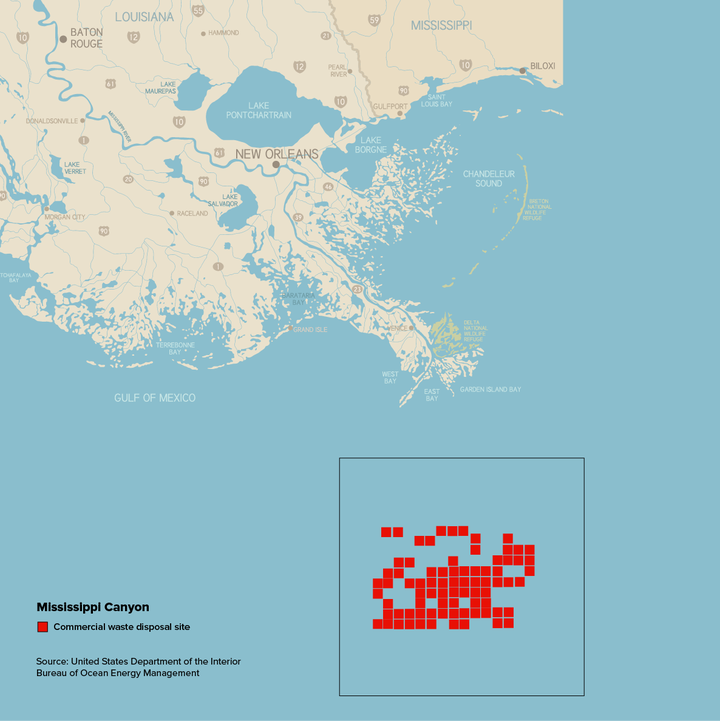The Biden administration’s oil and gas lease sale in the Gulf of Mexico last week doesn’t just lock in decades of future drilling and greenhouse gas emissions, it also opens up more extraction in an area where chemical companies dumped tons of hazardous industrial waste.
Off the coast of Louisiana, in an area known as Mississippi Canyon, thousands of 55-gallon drums containing decades-old toxic waste remain scattered across a 200-square-mile stretch of ocean floor, as HuffPost revealed earlier this year. Chemical giants received federal permits to dump waste material there in the 1970s, and there has been little oversight of the area in the decades since.
The Environmental Protection Agency has acknowledged it is not monitoring the legacy dumping ground and has little if any understanding of the lingering environmental impacts. In light of HuffPost’s reporting, the agency said it had launched an assessment to determine whether the site qualifies for cleanup under the federal Superfund program.
But the decades-old waste hasn’t deterred fossil fuel interests in the area. Oil and gas companies are already drilling within the barrel field, with federal agencies allowing them to determine how best to avoid and reduce impacts to existing drums. In fact, it was a Shell drilling plan that shed light on the condition of remaining barrels, noting that many “still look intact” and “may or may not still contain their original content.”
During last week’s auction — the largest offshore oil and gas lease sale in U.S. history — Chevron Corp., Murphy Exploration & Production Co., and Houston Energy LP secured new drilling rights on offshore leasing blocks where barrels have been located.
Chevron paid $256,442.40 to lease two blocks that are part of the dumping ground. Murphy Exploration and Houston Energy paid $154,362.80 and $151,744.80, respectively, to lease one block each.
Those three companies did not respond to HuffPost requests for comment.
As with previous Gulf lease sales, the Bureau of Ocean Energy Management alerted would-be bidders of the “inactive industrial waste disposal site” in its final sale notice.
“The site was established by the [Environmental Protection Agency] in 1973 under the Marine Protection, Research, and Sanctuaries Act to permit the seafloor deposition of approximately 205,000 steel barrels containing chemical wastes and chlorinated hydrocarbons,” reads the notice. “Bidders and lessees are advised that the blocks associated with the disposal site and adjacent blocks that are included in the sale area may exhibit hazards from barrel contents (toxic, corrosive, and/or potentially explosive materials).”
The document lists leasing blocks where barrels are known to exist, but that likely doesn’t paint a full picture. Ocean surveys have turned up barrels as far as 10 miles from the designated dump boundary, according to past notices to lessees.

At the Mississippi Canyon site, fuel additive company Ethyl Corp. got EPA approval to dump approximately 19,000 barrels of waste sludge containing liquid metal salts and calcium — drums that could still pose an explosive hazard. And DuPont jettisoned at least 1,300 barrels of waste, including “a wide variety of inorganic salts, industrial organics and chlorinated hydrocarbons” from its facility in LaPlace, Louisiana, according to a 1975 National Academy of Sciences report on ocean contaminants.
Chlorinated hydrocarbons, or CHCs, are a family of toxic chemicals that can persist in the environment and become concentrated in marine organisms.
Scientists HuffPost previously interviewed voiced concerns about the potential for these substances migrating up the food chain, where they could pose a risk to human health. They also argued oil giant Shell’s internal policy of maintaining a 33-foot standoff distance from barrels is insufficient to keep from disturbing remaining contents.
“Hazards surveys are required before bottom-disturbing activities can be approved in plans and permits,” the Bureau of Ocean Energy Management wrote in its notice for last week’s Gulf sale. “Drilling and platform/pipeline placement may require precautions, such as avoidance (recommended 30-foot minimum distance from individual barrels), decontamination of equipment, and personnel health and safety procedures.”
An EPA spokeswoman told HuffPost it is on pace to complete its initial Superfund screening by the end of the year.
It is unclear whether BOEM considered excluding portions of Mississippi Canyon from its recent lease sale pending the outcome of the EPA’s assessment. BOEM spokesperson John Filostrat said the bureau is not in a position to comment on the EPA’s pending report.
“For Sale 257, BOEM included lease exclusions and stipulations to protect biologically sensitive resources, mitigate potential adverse effects on protected species, and avoid potential conflicts between oil and gas development and other activities and users in the Gulf of Mexico,” he said via email. “Prior to any activity taking place on the Outer Continental Shelf, companies are required to survey the seafloor and shallow water sediments to identify potential hazards before conducting any bottom disturbing activities. This allows for any hazards to be avoided.”
Environmentalists and climate activists forcefully decried the Biden administration’s Gulf of Mexico lease sale last week, which stands at clear odds with the president’s own climate goals and comes at a time when the world can least afford wealthy nations expanding fossil fuel development.
The auction ultimately brought in more than $191 million, with oil and gas companies purchasing rights to drill across more than 1.7 million offshore acres — an area larger than the state of Delaware.
